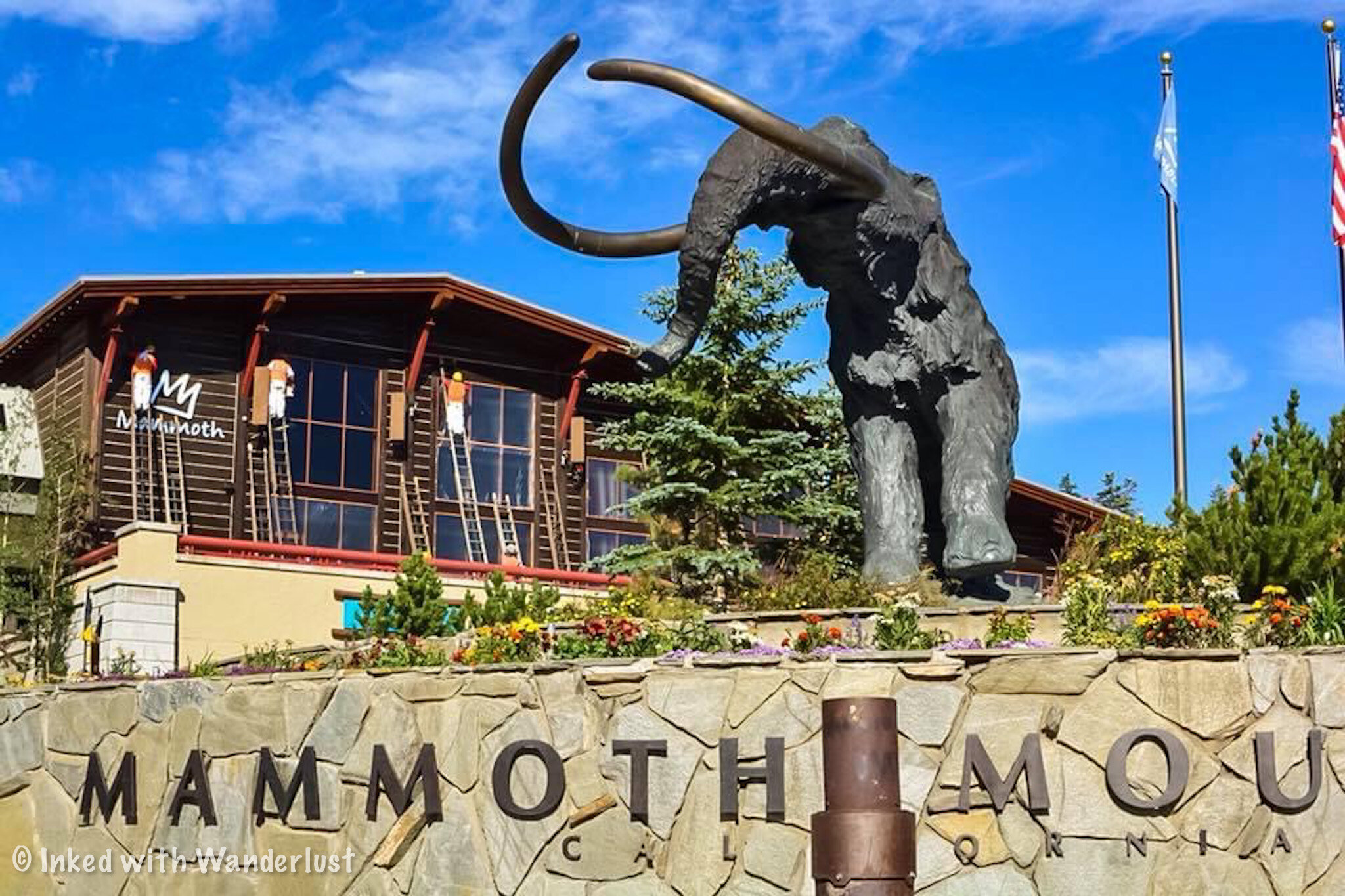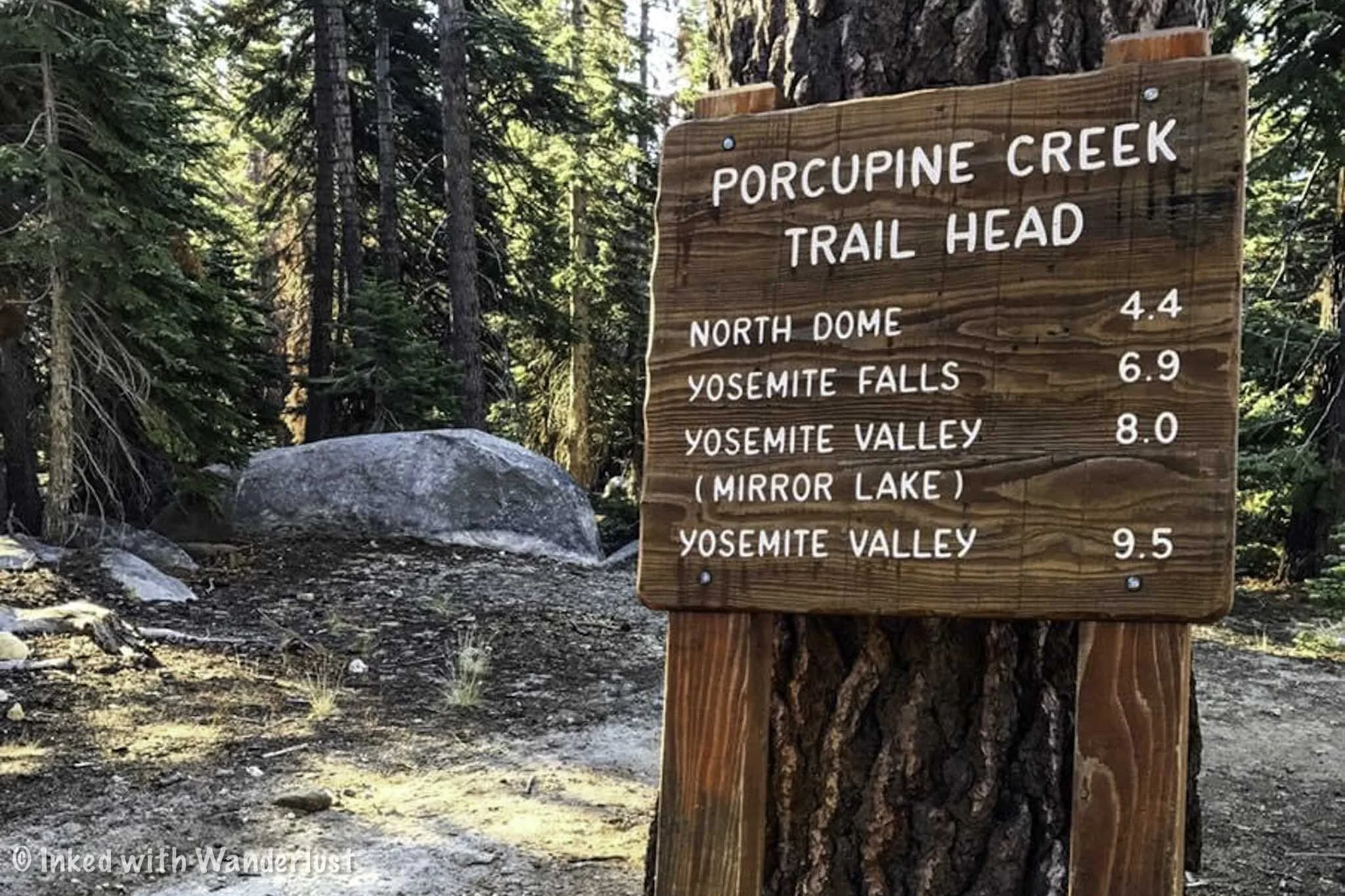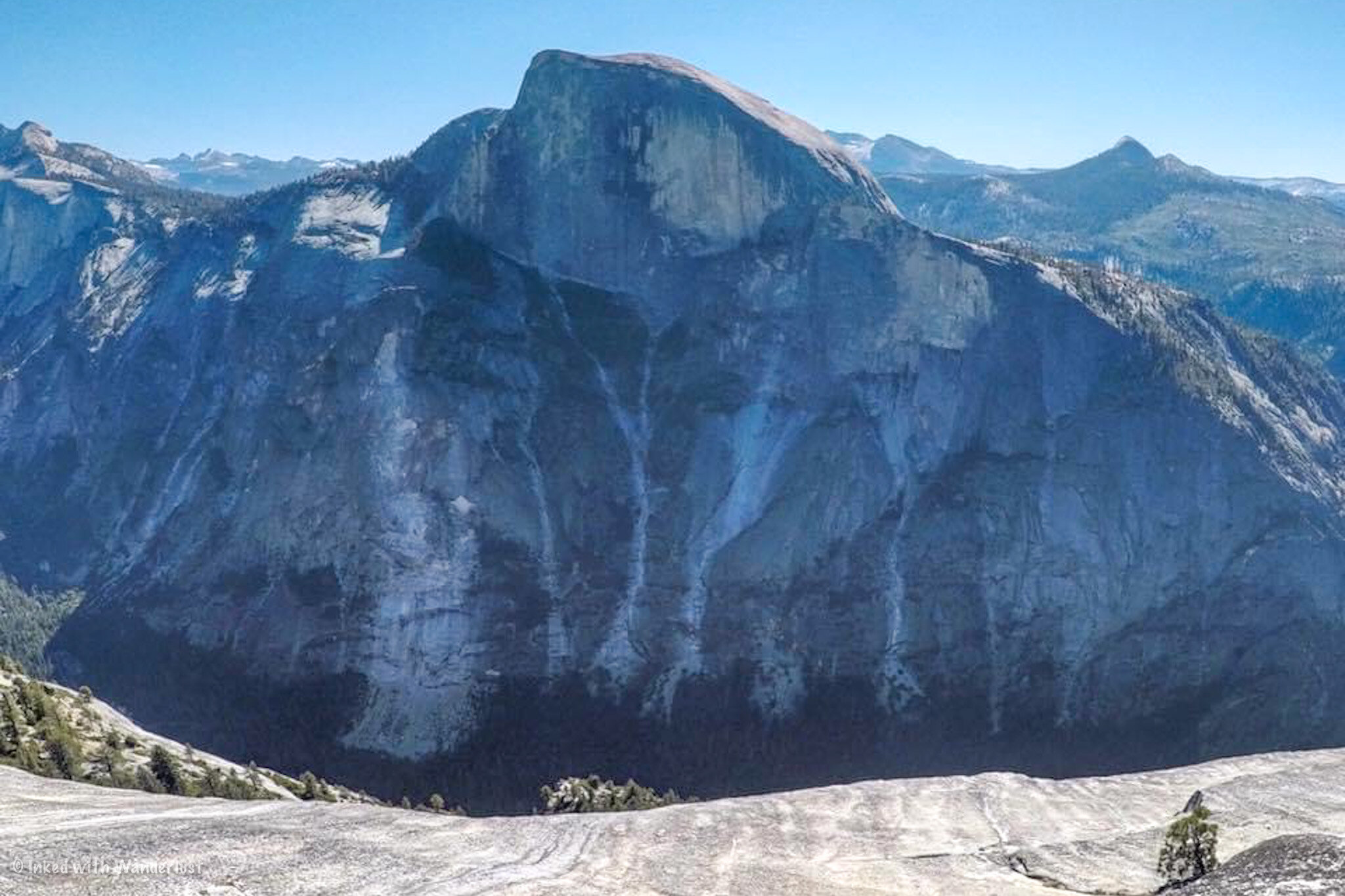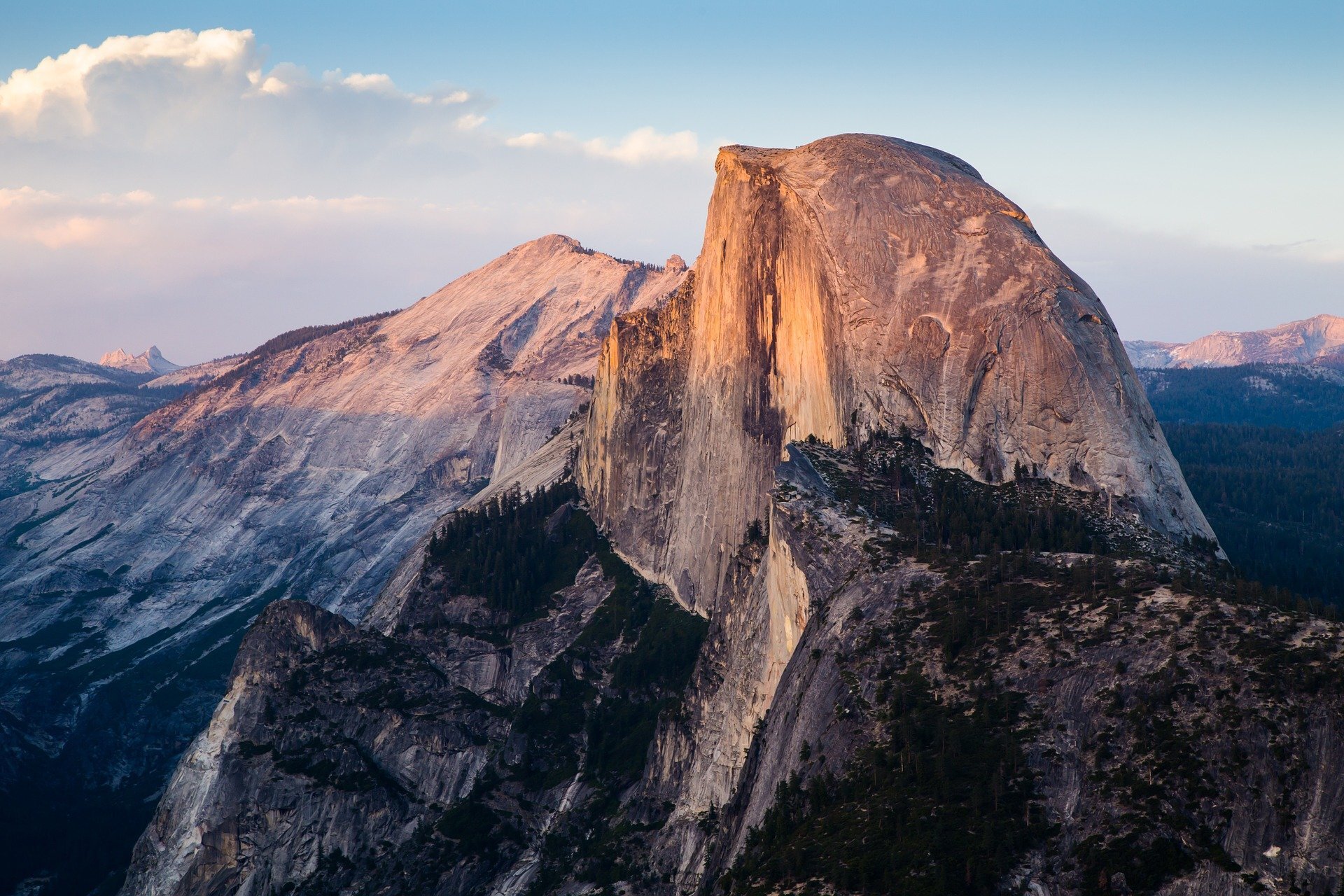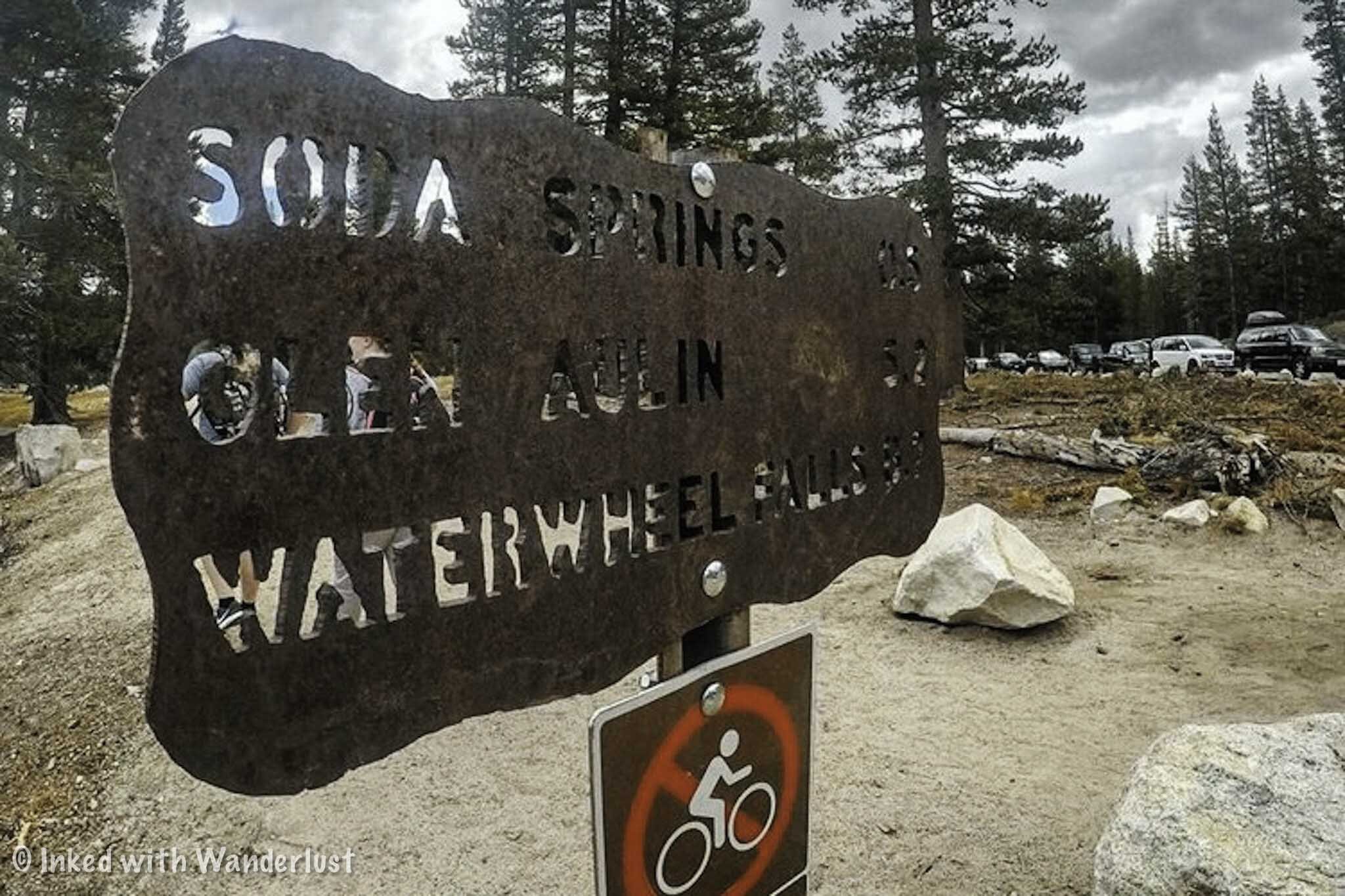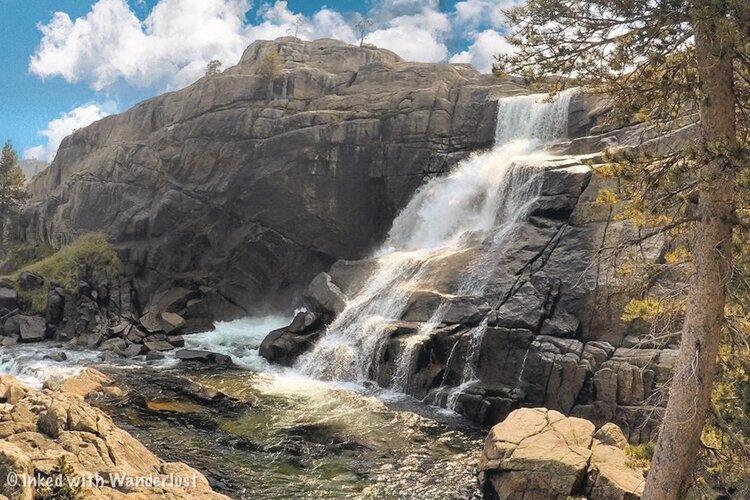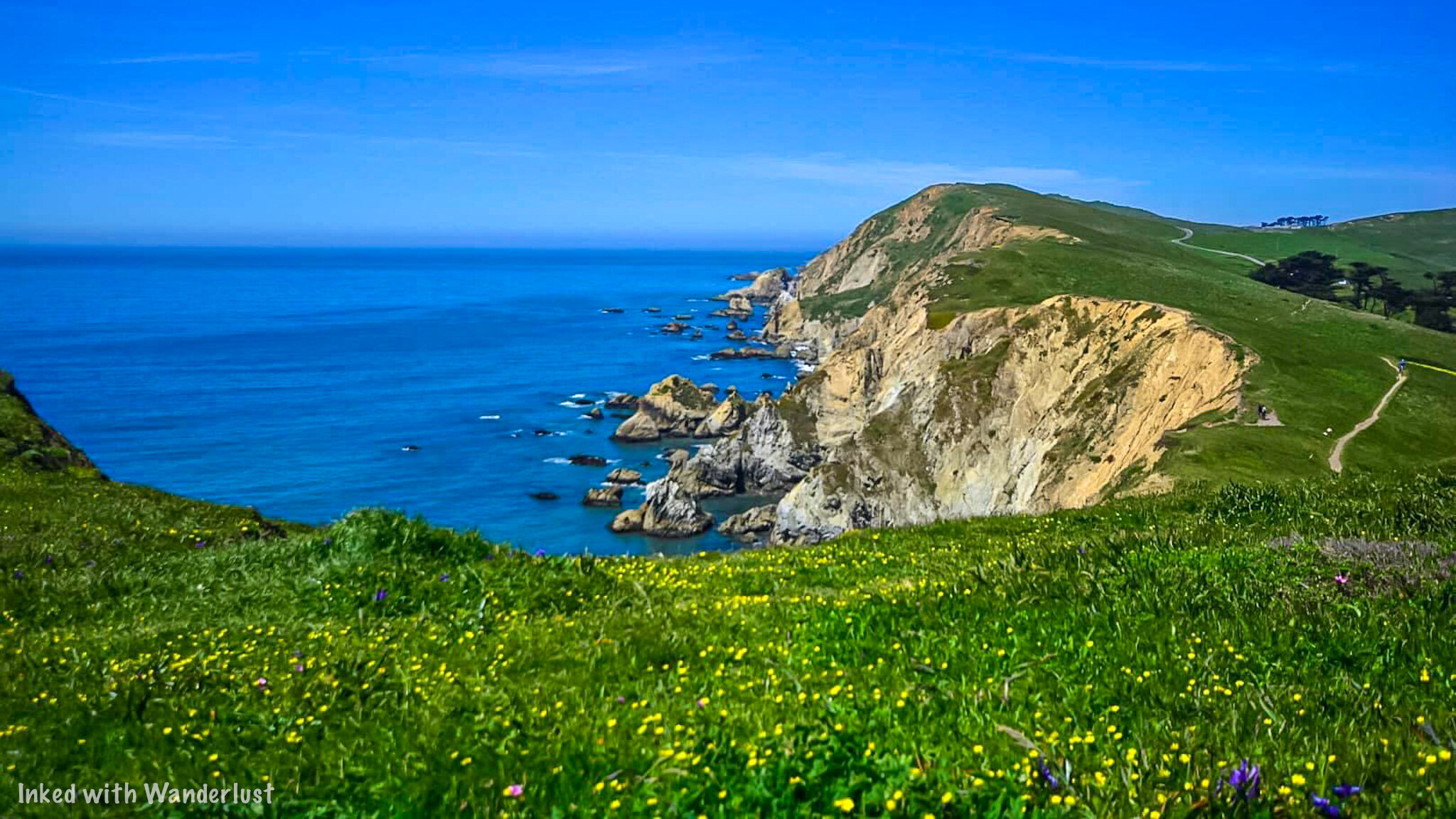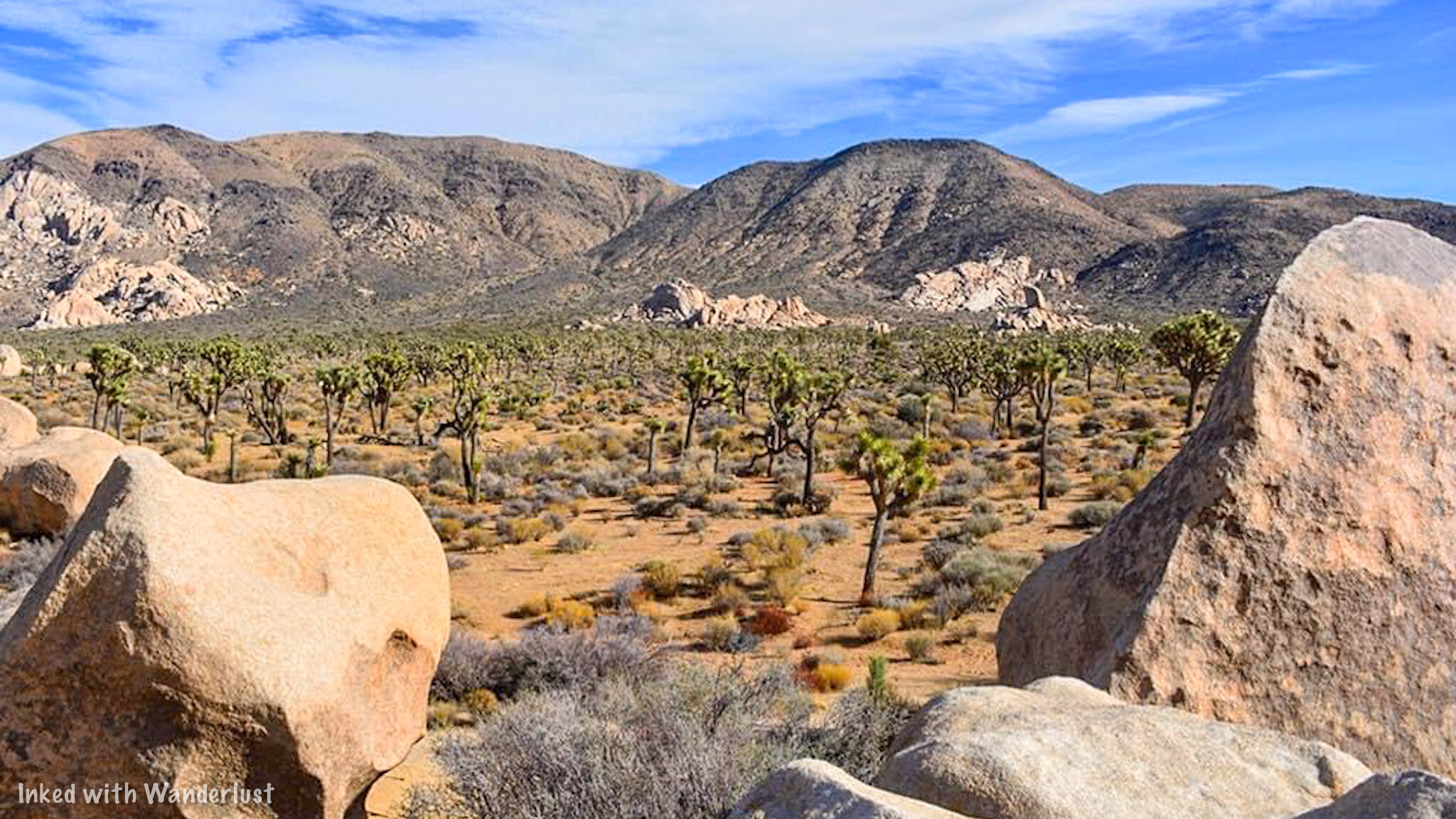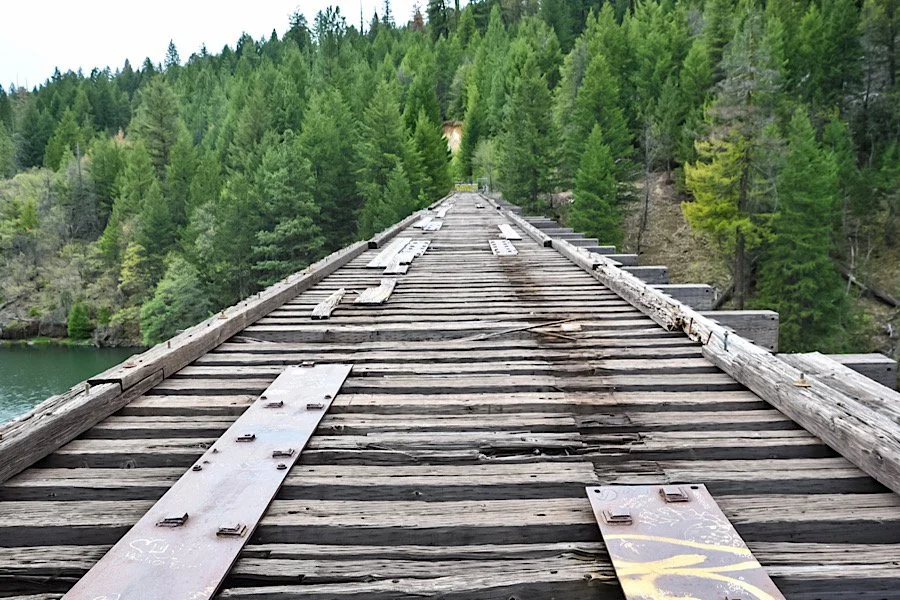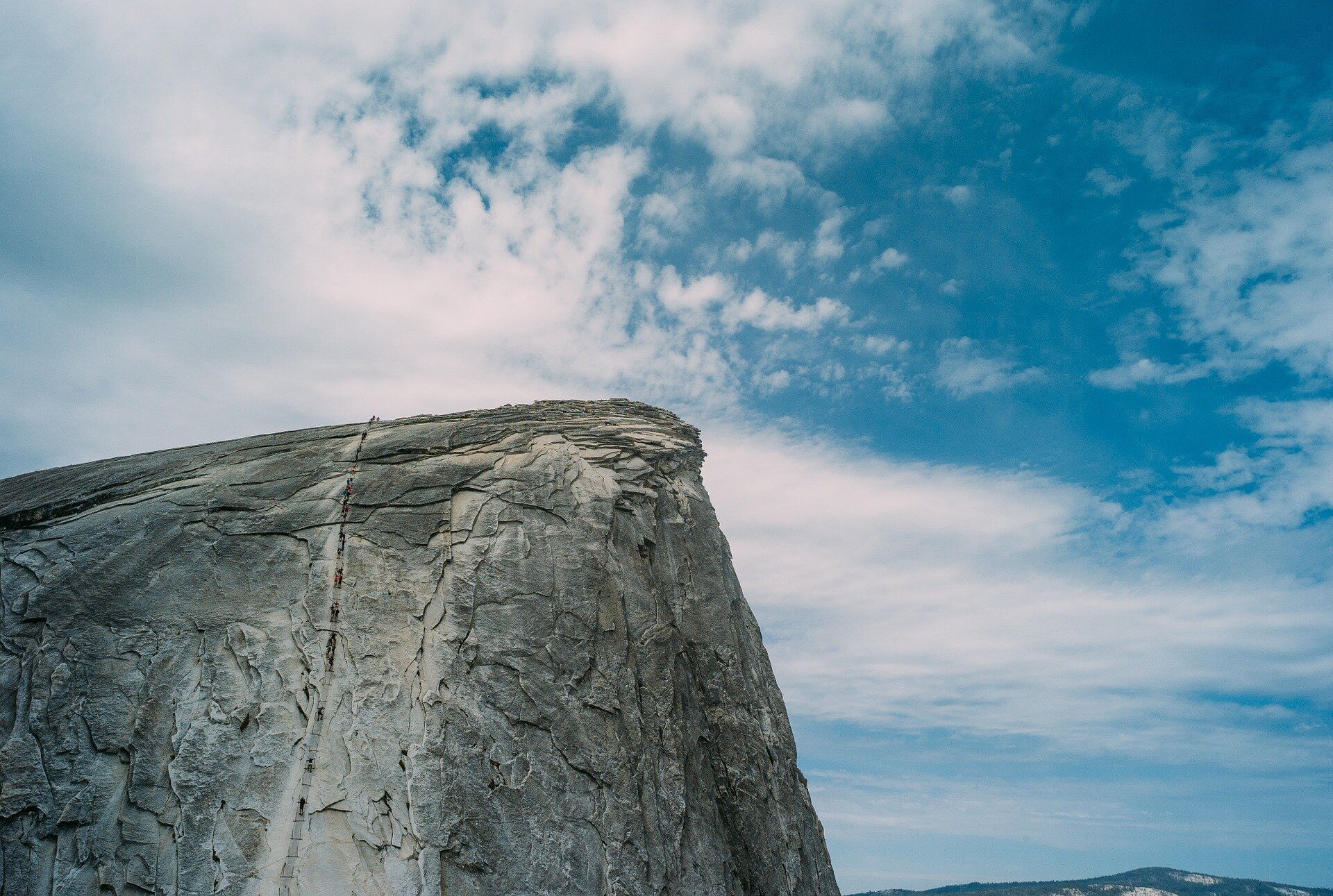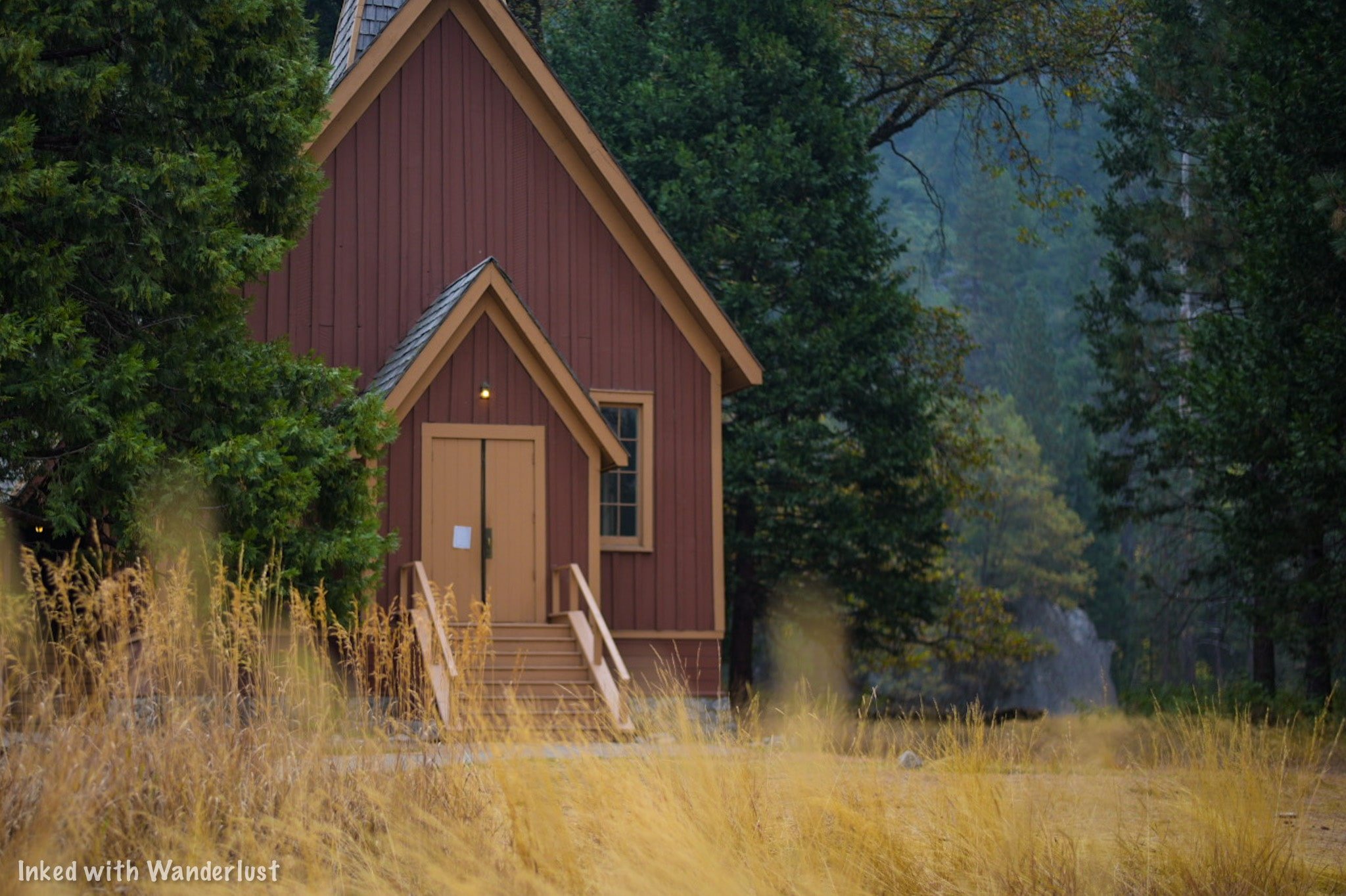Visit Devil's Postpile National Momument in California
Formed roughly 80,000 years ago, the up to 60 foot basalt columns of Devil’s Postpile National Monument are a sight to behold. The saying, “you won’t believe it until you see it”, holds
Formed roughly 80,000 years ago, the up to 60 foot basalt columns of Devil’s Postpile National Monument are a sight to behold. The saying, “you won’t believe it until you see it”, holds true in this case. Pictures do no justice to this natural masterpiece.
Read along to find out how you can see it for yourself and witness one of the best examples of how much of a role Volcanos played in shaping the Sierras as we know it today.
Mammoth Mountain
Your journey to Devil’s Postpile begins at the base of Mammoth Mountain in Mammoth Lakes, CA. With few exceptions, most visitors will be required to utilize the Monument’s shuttle that takes you down the access road to the valley.
The Shuttle
While the Monument itself is free, there is a fee to use this mandatory shuttle. Tickets can be purchased at the Adventure Center day of and as of 2019 it is $8.00 per person 15 and older, $4.00 per person between 3-15 years old, and free for those aged 2 and under (The shuttle rule was suspended in 2020 due to COVID-19).
As stated above, there are a few exceptions to this rule. They are:
Arrive before 7am or after 7pm
Have a handicap placard or plate
Are staying at either the valley campground or Red Meadow’s Resort.
You’re arriving after shuttle operating hours or season
You’re a hunter transporting game or weapons
You’re towing livestock and are using the livestock on valley trails
You have a cartop boat and are using it in valley lakes
READ ALSO: 7 Things You Will Love About Lee Vining
The shuttle runs on average every 45 minutes and usually takes 30 minutes or so to reach the valley. The line moves quickly due to plenty of seating on each shuttle along with some standing room (pro tip: If you’re standing, avoid locking your knees. Someone on the bus with me ate floor because of this).
Much like Yosemite’s east side, the Monument is seasonal and typically opens in mid June and closes in mid to late October. Be sure to keep this in mind when planning your trip.
Devil’s Postpile
The shuttle will make multiple stops along the access road. While you can reach the columns from Red’s Meadow, you’re going to want to get off at the Valley stop as this is the most direct and shortest route.
The valley is where you’ll find the campground, ranger station, bathrooms, and Soda Springs Meadow (which is where the trail to the columns begin). You can find the trailhead to the columns just beyond the Ranger Station.
It is just shy of .05 mile from the start of the trailhead to Devil’s Postpile. The trail is well maintained through Soda Springs Meadow but beyond this, you’ll start noticing thick tree roots and rocks getting in the way.
From here, it won’t be long before you get your first glimpse of Devil’s Postpile and when you do, you’ll be blown away. The columns formed around 80,000 years ago (give or take) after flowing lava cooled and cracked into what we see today.
Just as you come upon it keep an eye out for a side trail to your left. This trail will take you to the top of the columns and allow you to touch their smooth, hexagon shaped surface. The trail is a bit steep but freight not, it’s short.
Take all the time you want to admire and photograph this amazing sight. The sun rises above the columns so the morning light tends to be harsh. I found the light much better on my way back out when the sun had time to move on. So if you want to get some good pictures, keep this mind.
Rainbow Falls
You now have two choices. You can either stop here and head back to the shuttle once you’ve spent enough time admiring the Postpile or you can press on and head out to the other natural feature of the Monument; Rainbow Falls.
From here, it is another two miles to the falls. While that isn’t a lot and the trail is mostly flat with the occasional dip, there isn’t much in the way of shade. You’ll have a few opportunities here and there but for the most part, it’s exposed. So if you’re going to continue on, be sure that you brought plenty of water with you.
Between the postpile and the falls you’ll have amazing views of the San Joaquin River as you follow along side of it. Eventually, you’ll come out into a vast clearing (where a massive fire tore through) and be able to see the beautiful Minerats out in the distance to your right.
Soon enough, you’ll start to hear the roaring of the beautiful Rainbow Falls. Your first glimpse will come as you approach the main (and largest) concrete viewpoint.
If you’re looking for a better viewpoint with a more straight on angle of the falls, keep going down the path and you’ll eventually see it off to your right. When I was here, this one had far less people than the first one.
There are also stairs that lead down the base of this 101-foot beauty where you can get some amazing photos but unfortunately, these stairs were closed to the public for maintenance when I was there. More of a reason to go back, right?
Lower Falls
Located about a mile further down the trail from Rainbow Falls and outside the boundary of the Monument is Lower Falls. Lower Falls drops just 15 feet over smooth granite rocks and into the perfect swimming hole for overheated hikers.
My friend and I debated over whether or not to include this on our visit. Ultimately, we decided to do it and I was sure glad we did. Lower Falls is comparatively unknown to most visitors so we only had to share it with a few others (we were here in August). I highly recommend going for it.
Things to Know
Mileage will vary. If you only hike to the columns, you’re looking at just under a mile from the valley to the columns and back. If you go to Rainbow Falls, that’ll make it 5 miles round trip and if you include Lower Falls, it’s about 7 miles round trip.
The Monument is free, but the shuttle isn’t. If you manage to arrive outside the operating hours of the shuttle, you’re free to drive down to the valley. Otherwise, you must pay for and use the shuttle.
The Monument is seasonal. Due to heavy snowfall, the Monument is only accessible from mid June to around mid to late October. So plan your visit accordingly.
Crowds get heavy. Devil’s Postpile is one of the most popular attractions in the Sierras. As such, crowds tend to be heavy. Your best bet for light crowds is in the morning because later in the day, lines for the shuttle will rival those of Space Mountain.
Your annual parks pass won’t waive the shuttle fee. Keep this in mind if you’re a pass holder. Everyone pays for the shuttle.
The trail to Devil’s Postpile is (kind of) wheelchair and stroller friendly. I know of people who have pushed strollers along this trail and others who have used a wheelchair, but they did struggle. As you approach the columns, there’s a ramp to help circumvent the rocky stairwell but you will encounter thick tree roots and rocks along the trail. Beyond the columns to the falls, wheelchairs and strollers won’t be possible.
Bring plenty of water. Seriously. I underestimated this trail due to it being short but didn’t realize how exposed the trail to Rainbow Falls is and was nearing dehydration. Learn from my screw up.
Conclusion
Whether you decide to just see the columns or include Rainbow and Lower Falls in your visit, you’re sure to enjoy the time you spend at Devil’s Postpile National Monument.
We hope this article has inspired you to want to visit this beautiful place. If so, please support us by sharing it with your family and friends on your favorite social media site.
Thanks for reading and safe travels!
Hike to North Dome and Indian Rock Arch in Yosemite National Park
While hiking Half Dome requires a permit and a great deal of planning, hiking neighboring North Dome requires nothing more than a drive up to the trailhead…
Disclosure: This post contains affiliate links. If you make a purchase through these links, I may earn a small commission at no additional cost to you. I only recommend products or services that I believe will add value to my readers.
While hiking Half Dome requires obtaining a permit and a great deal of planning and preparation, hiking neighboring North Dome requires nothing more than a drive up to the trailhead and strong legs.
Due to this, many see North Dome as an excellent alternative to Half Dome if you were unsuccessful in the permit lottery or if Half Dome is too daunting. There are no cables or climbing involved and best of all, you’ll be in a position to get one of the best views of Half Dome in the entire park.
So where is the trailhead for North Dome? What’s the parking situation like? Like to know what to expect on this trail? What’s Indian Rock Arch? I answer all of these questions and more in the post below. Let’s get into it.
North Dome Trailhead and Parking
Although you’re technically able to reach North Dome from the valley, the official trailhead is just off Tioga Road on Yosemite’s east side and can be found in the Porcupine Creek parking lot (do not confuse this with Porcupine Flat).
From Yosemite Valley, follow the signs to Highway 120. Ten miles after leaving the valley you’ll come upon Crane Flat. Turn right there and after twenty-five miles or so, you’ll arrive to the parking lot on your right.
From Yosemite’s east entrance, simply drive for about twenty miles after driving through the gate and you’ll reach Porcupine Creek on your left. If needed, there are pit toilets located in the parking lot.
As is the case with most Yosemite trailheads, the earlier you arrive, the better off you’ll be. I arrived to the trailhead at around 7am and there was only one other car. When I got back to my car after the hike, around 2pm, every spot was occupied.
The North Dome Trail
Much of the route to North Dome is your standard, albeit beautiful, walk in the woods. The scenery is stunning as you’re surrounded by hundreds of moss-covered trees and granite boulders.
You’re starting at 8,100 feet at the parking lot and you’ll work your way down to 7,540 feet at North Dome. While there will be some slight incline on the trail, you are ultimately going downward the whole time.
This is great on the way in and will feel like a breeze, but you’ll definitely feel it on your way back to the car (especially in the final mile or so). Total mileage, without taking the detour to Indian Rock Arch is 8.8 miles, round-trip. With the detour (highly recommended), you’ll add another mile or so.
Indian Rock Arch Detour
About 2/3rds of the way to North Dome, you’ll come across the half mile (one way) detour to Indian Rock Arch on your left. It is the ONLY natural granite arch located within Yosemite. The arch is about 15 feet tall and sits atop a hill with commanding views at the top.
My recommendation would be to take the detour on the way in, rather than on the way back. This way, you can save your energy and endurance for the elevation gain you’ll still need to navigate.
North Dome
After checking out Indian Rock Arch, continue your way to North Dome. After another mile or so, you’ll come into a clearing and get your first glimpse of both North Dome and Half Dome in the distance. Don’t stop here, the views are just getting started.
Eventually, you’ll reach a point where it feels like you’ve lost the trail. You haven’t. Just keep Half Dome in your sights and stay to the left (down) and you’ll pick it back up again. If needed, there are typically cairns all over the place to help guide you.
After dropping down from the granite you were just on, you’ll once again find yourself surrounded by trees and will have lost sight of Half Dome. Keep with the trail and after a short while you’ll come to another clearing. Here, you’ve officially made it to North Dome.
Half Dome will have a commanding presence as you continue to work yourself down to North Dome’s precipice and on arrival, you’ll have an amazing view of not only Half Dome, but Tenaya Canyon and the many highlights of Yosemite Valley as well.
Things to Know About the North Dome Hike in Yosemite
The trail is inaccessible in winter. The North Dome trail is on Yosemite’s east side on Tioga Road and due to heavy snowpack, this area of the park is closed in winter. Typically, it’ll open for the season at the end of May or beginning of June and closes with the first major snowfall of the year (typically late October/November).
North Dome isn’t easy, but it isn’t difficult either. You’ll be starting out at a higher elevation and work your way down, which is the easy part. Where it could get moderately challenging for some is on the way back out. As long as you’re prepared for this, you’ll do just fine.
North Dome itself is generally safe, but use common sense. North Dome doesn’t see the amount of hikers Half Dome does, so it isn’t overly slick. However, getting too close to the edge could result in a deadly slide into Tenaya Canyon or Yosemite Valley. Using footwear with good grip is advisable and of course, watch your footing.
It doesn’t get too crowded. It’s nowhere near as bad as the trails in the valley, such as the Mist Trail, or some of the neighboring trails on Tioga road (Cathedral Lakes, Tuolumne Meadows, etc). If you get an early start, you’ll likely have it mostly (or all) to yourself. Starting later will likely mean more people on the trail, though.
North Dome is NOT the same as Half Dome. There are no cables or climbing involved and it’s roughly half of the total milage as Half Dome. North Dome is a great alternative to those seeking similar views as Half Dome provides (albeit from a lower vantage point), but don’t want to bother with the red tape or the challenge of Half Dome.
Glen Aulin: A Glorious Hiking Trail in Yosemite
I’m often asked by Yosemite first timers (friends and friends of friends) about which hiking trails in Yosemite should they hike during their visit…
Disclosure: This post contains affiliate links. If you make a purchase through these links, I may earn a small commission at no additional cost to you. I only recommend products or services that I believe will add value to my readers.
I’m often asked by Yosemite first timers (friends and friends of friends) about which hiking trails in Yosemite should they hike during their visit. There are many beautiful hikes in Yosemite, but one of the few I recommend most often is the Glen Aulin trail, located in the Tuolumne Meadows area of the park.
Its not the easiest hike in Yosemite, nor is it the shortest, but it’s far from difficult and I’d say that as long as you and your family have hiked, a minimum, a few times, then you shouldn’t have any issue with Glen Aulin. It’s a straight shot and mostly level throughout, making it an ideal hike for families.
Before we get into it, you need to know that this trail is located in the high elevation area of Yosemite’s east side. This area of the park receives tons of snow in the winter, making it inaccessible during that time. If you want to hike the Glen Aulin trail, you’ll need to plan a summer or fall visit as the east gate typically opens in late May or early June.
However, even at those times, there could still be heavy snow pack along the trail. If you want to avoid snow and/or muddy conditions, I recommend visiting in late summer or in the fall when the weather is pleasant.
Now that that’s out of the way, let’s get into it!
Glen Aulin Trailhead Parking
The official trailhead for Glen Aulin begins just to the right of Parson’s Lodge and Soda Springs in the back-end Tuolumne Meadows. However, you must begin on the opposition side of the meadow, which adds some milage to your hike, but not a lot.
Unless you’re starting from the Lembert Dome area, there is no official parking lot for this hike. Some attempt to park on the side of the road, but you’re risking being cited and towed. I would play it safe and park in the visitor center parking lot across the street.
Glen Aulin Hiking Trail
Once you’ve secured a spot, make sure there isn’t anything with a smell in your car or trunk, as this area sees a lot of bear activity. This includes food, drink, deodorant, etc. There are bear lockers everywhere in the area free to use.
To start your hike, cross the street and look out for the trailhead sign that lists Soda Springs, Glen Aulin and Waterwheel Falls (pictured above). You’ll want to follow the dirt path to the opposite end of Tuolumne Meadows.
The first notable feature you’ll encounter is the picturesque bridge spanning over the Tuolumne River. If you arrive early, do yourself a favor and get your pictures in now because on your way out it’ll likely be littered with tourists.
After the bridge you’ll come across Parsons Lodge (slight left) and Soda Springs (slight right). Parson’s Lodge was built by the Sierra Club in 1915 as a memorial to Edward Taylor Parsons (club member and Yosemite advocate). Soda Springs is a mineral spring with a half cabin built around it.
Don’t spend too much time here, because you haven’t officially started the actual trail yet and still have a ways to go. Keep going past Soda Springs and the lodge and you’ll see signs pointing you toward Glen Aulin trail, proper.
Glen Aulin shares its trail with both the PCT and the JMT. So if you see signs for either or both, you’re going in the right direction.
The first half-ish is fairly flat and straightforward. It’s clearly marked and well-maintained so there’s no real risk of going off-track. At around the three mile mark, you’ll come out into a beautiful meadow and lake that rivals Tuolumne Meadows (in my opinion).
Shortly after this point is where the trial starts to get a bit rocky and less maintained. However, the views continue to get better and better. For the next couple miles, you’re zig-zagging along beautiful cascades and have jaw dropping views of the granite mountains out in the distance.
The closer you get to Glen Aulin, the more spectacular the cascades get. I hiked this late in the season and the river was going strong. I could only imagine how it looks earlier in the season.
Tuolumne Falls
Before reaching Glen Aulin, you’ll first find yourself at the beautiful Tuolumne Falls. This waterfall is simply breathtaking and worth spending some time at. Although no one was down there on my hike, I have heard of overheated hikers using the pool around the falls as a swimming hole. I would exercise caution if you decide to do so.
After soaking in the views and getting your pictures, continue down the trail. From here, you’re still another mile or so from your destination. This is where the drop in elevation will become more noticeable and trail becomes rockier than it was before. Watch your step and pace yourself, if needed.
White Cascades and Glen Aulin
This is one of those destinations that just sneak up on you. You’re wondering how much further you have to go and bam, you come off a slight descent and there it is, the beautiful Glen Aulin and White Cascade. The views in this area are simply stunning.
While there’s nothing wrong with enjoying the view from the initial side, you’ll want to keep going as the view is much better across the swimming hole. Head forward towards the bridge and cross it to get there.
Glen Aulin High Sierra Camp
As you’re coming off the bridge, take a right and head over to the Glen Aulin High Sierra Camp. Everyone and anyone is free to hang out around the camp and the swimming hole, but access to the tents and restrooms are only for registered guests.
The Glen Aulin High Sierra Camp is one of five camps scattered throughout some of Yosemite’s most popular locations. You can attain one by entering the annual lottery and crossing your fingers that you win one. Rates for the Glen Aulin Camp in 2024 are as follows:
$175 per night (Adults)
$90 per night (Children)
Rates include a stay in one of the tents, along with dinner and breakfast, with lunch available as an option for an additional charge. Bookings are available for stays from July 4 - September 7, 2024. You can get more information here. Keep in mind that each tent can fit four people and they will fill it. Depending on your party size, you may be sharing it with others.
The best part of the Glen Aulin High Sierra Camp is you’re camping directly next to the gorgeous White Cascades and swimming hole. Imagine waking up to that sight every morning and enjoying a prepared breakfast next to a fire. That beats any hotel I can think of.
Glen Aulin Hiking Tips
This trail gets crowded. For starters, the trailhead begins in Tuolumne Meadows, one of the most tourist-heavy areas of Yosemite. Additionally, it shares its trail with the PCT and JMT. The earlier you can get started, the better.
It’s a moderate level of difficulty. It’s not a difficult hike by any means, but it is on the longer side and rocky in the latter half. That said, it’s mostly level, straight forward, clearly marked and well-maintained. Just be prepared for the length of it and you’ll be fine.
This trail is seasonal. The Glen Aulin trail is located in Yosemite’s high elevation area and thus, receives a heavy amount of snow in the winter, making it inaccessible. The entire east side closes during this time. So plan a summer or fall visit if you want to hike Glen Aulin.
Bears do frequent this area. Bears are all over Yosemite. However, they tend to hang around Tuolumne Meadows and this trail quit a bit. I didn’t see any during my hike, but you might. If you do encounter a bear, make lots of noise to alert it of your presence, give the bear plenty of space and you’ll be fine.
Watch out for the pack horses! Supplies get down to Glen Aulin High Sierra Camp via pack horses. I encountered them 3 times on my hike. Keep an eye out for them and give them the right of way. You also may want to watch your footing after they pass, for obvious reasons.
Planning a trip to Yosemite? If it’s your first visit, be sure to read 10 Awesome Things to Do in Yosemite Valley on Your First Visit. Additionally, read Tunnel View: How to See the Most Iconic View in Yosemite for an epic view you won’t want to miss. Finally, if you’re thinking of hiking Half Dome, read How to Hike Half Dome: The Complete First Timers Guide.
IF YOU WANT TO SEE ALL OF YOSEMITE’S HIGHLIGHTS IN A DONE-FOR-YOU, HASSLE-FREE TOUR WITH KNOWLEDGEABLE GUIDES, GO HERE.
26 Best California Destinations for 2021
2020 was one for the books, wasn’t it? Covid-19, earthquakes, travel restrictions, no indoor dining, and least we forget…murder hornets. Due to the travel restrictions, most people had to forego their travel plans for the year
2020 was one for the books, wasn’t it? Covid-19, earthquakes, travel restrictions, no indoor dining, and lest we forget…murder hornets. Due to the travel restrictions, most people had to forego their travel plans for the year and that is what inspired this post.
I have to believe that a lot of you had plans to visit California in 2020 but could not. With things looking up due to the availability of the vaccine, you may be starting to resume vacation plans for 2021. If so, this post is for you.
This is assuming that things will improve and get back to normal in 2021. If things don’t, then I obviously recommend that everyone do their part and respect the rules at each individual site should you decide to travel.
Without further delay, here is my list of the 26 best California destinations for your 2021 vacation.
1) Yosemite National Park
I’ve said it before and I’ll say it a thousand times more; if you’ve never been to Yosemite, you need to start planning now. If this list was just for the top 3 places in California, Yosemite would still make it. Do keep in mind that throughout the 2021 summer season, you will need a day use reservation in order to drive into the park.
READ ALSO: How To Make A Day Reservation For Yosemite National Park
2) Big Sur
Rugged coastlines, seaside cliffs, ocean views for miles, and many beautiful state parks, Big Sur should be at the top of everyone’s California bucket list. Making it an even better destination is its proximity to other small coastal towns such as Carmel, Monterey Bay, and Santa Cruz.
3) Disneyland Resort
Closed for much of 2020, Disney fans are eagerly waiting for the park’s reopening in 2021 (myself included). Both Disneyland Park and neighboring California Adventure are California staples and are sure to return to their former glory once they’re allowed to resume operations.
4) Devil’s Postpile
Also closed for much of 2020 and its shuttle service suspended due to covid, Devil’s Postpile is poised for big crowds this year wanting to see this massive volcanic masterpiece. If everything goes according to plan, you can expect the monument to open sometime in mid-June.
READ ALSO: How To Visit Devil’s Postpile and Rainbow Falls
5) Golden Gate Bridge
One of the most recognizable landmarks in not just the state, but the entire world, the Golden Gate Bridge is a sight to behold and experience. Did you know that you could walk across it? On both sides of the bridge are walking paths that give you walking and biking access to this engineering marvel.
6) Bodie State Historic Park
There are many abandoned ghost towns in California but for my money, Bodie tops the list. Often referred to as the, “Disneyland”, of ghost towns, Bodie offers dozens of well preserved buildings and the mill from its gold rush era.
READ ALSO: The Complete Guide For Your First Trip To Bodie
7) Point Reyes National Seashore
A well preserved portion of California’s rugged coast, Point Reyes offers epic views, beautiful beaches, ship wrecks, and enough sea lions to provide endless hours of entertainment. Make sure to get a map at the visitor center because there are many unmarked side roads to explore.
8) Mono Lake South Tufas
Located in the small mountain town of Lee Vining, Mono Lake is a saline soda lake that was formed close to 800,000 years ago. The Tufa’s are columns of limestone rock and make for an otherworldly environment, to say the least. Stand on the shore and admire it or go for a swim. Just make sure you don’t have any open cuts on your body. It will hurt.
9) Joshua Tree National Park
Located in Southern California, this National Park contains the largest concentration of Joshua Trees found anywhere in the world! You could easily spend a few days exploring this park or if you’re in a time crunch, seeing it in a day is also possible by driving through the main road.
10) Hike to the Hollywood Sign
While the Hollywood sign can be seen from multiple viewpoints, what could be better than hiking to the top and getting an epic view (albeit from behind)? The trail to the top is moderately strenuous but doable.
11) Hike Lundy Canyon in the Fall
There’s never a bad time to hike Lundy Canyon, but hiking it in the fall is the best! Fall colors, especially at their peak, pop like none other in this nature made wonderland. The trail is well maintained and can be strenuous for some.
12) Emerald Bay (Lake Tahoe)
The entirety of Lake Tahoe is always worth a visit, but my favorite area of the lake is Emerald Bay State Park. Multiple hiking trails, a scenic viewpoint, waterfalls, and an old historic castle can all be found here.
13) Alabama Hills
A place I like to call, “Whitney’s front yard”, Alabama Hills is just outside of the small town of Lone Pine and is a major destination for adventure seekers. The best part is it’s BLM land, so camping is free and always available.
14) Hike Half Dome
Half Dome is one of Yosemite’s most recognizable landmarks and one of the countries premier hiking trails. I hiked it in 2017 and hope to do so once again this year. It’s not for the faint of heart, though. Training and preparation is key.
READ ALSO: Hiking Half Dome: The Complete Guide To Yosemite’s Best Day Hike
15) Convict Lake
Convict Lake is super easy to get to; you simply pull up and enjoy! There’s an easy going trail that partially circles the lake and some picnic benches scattered throughout its beaches. Fall, in particular, is a great time to visit.
16) Summit Mount Whitney
Mount Whitney is the highest point in the lower 48 and the second highest overall (the highest is Mount Denali in Alaska). Despite its elevation, it’s a fairly straight forward trail to the top and makes for an unforgettable 2-3 day hike.
17) Lake Shasta Caverns
Located in Mount Shasta’s foothills and 900 feet above Shasta Lake, the caverns are a must do for any family or adventurer. The tour includes a guide, a boat ride across the lake, and the tour of the caverns itself.
18) Burney Falls
Seeing this 129-foot natural wonder is an absolute must! This waterfall is easily accessible so everyone and anyone can enjoy it. There’s also a trail that circles above the falls and loops back around to the base.
READ ALSO: The Essential Guide To Visiting Burney Falls
19) Lassen Volcanic National Park
Never been to Yellowstone? Head over to Lassen to get a small taste of what it’s like. Beautiful lakes, waterfalls, mountain tops, and volcanic activity all come together to create a beautiful park like none other.
20) Bridgeport
A small blink-and-you-miss-it town, Bridgeport is one of California’s best towns for outdoor enthusiasts. Hiking, fishing, kayaking, mountain climbing, ghost towns, and more can all be enjoyed here!
READ ALSO: 7 Things You Will Love About Bridgeport
21) Catalina Island
Catalina Island is located 22 miles off of California’s southern coast and features the perfect combination of adventure and relaxation. You could kayak it’s shores in the morning and relax on the beach with a cold drink later that evening.
22) San Diego
One of California’s major cities is also one of its most beautiful. The San Diego Zoo, Marina, La Jolla Shores, Old Town, and more. It’s located just a couple hours south of Los Angeles, making it a fairly easy day trip.
23) Tour Alcatraz
Tour California’s most infamous prison that once housed Al Capone and several other notable names from the criminal underworld. The prison shut down in its official capacity in 1963 and was reopened as a tourist attraction 10 years later. Tours depart daily from San Francisco.
24) Ride Trolleys in San Francisco
In my opinion, San Francisco is THE most gorgeous big city in California. There’s so much to do and see; no article could cover it all. One of the most classic things to do is ride their world famous street trolleys through its hilly roads. You have to do it at least once.
25) Wine Tasting in Napa
Are you a wine aficionado? If so, you need to book a trip to Napa. There’s so many wineries and fine dining restaurants that you will have a hard time trying to fit them all in. You could go about it yourself or book a tour to handle it all for you.
26) Manzanar National Historic Site
Last, but certainly not least, a visit to Manzanar is a must for everyone, in my book. Manzanar was used as a relocation camp for Japanese-Americans during World War II. It’s a sad, unfortunate reminder of our past but places like this have the power to inspire us to be and do better.
READ ALSO: Manzanar National Historic Site: The Complete Guide For Your Visit
There you have it. 26 amazing destinations in California that would make a perfect vacation for you and your family in 2021. Did I miss something that you think so be on the list? Tell me about it in the comments below.
Safe travels. Thanks for reading!
Please support this site by sharing this article with your family and friends on Pinterest, Facebook, or your favorite social media site.
You can further show your support by reading one or more of the related posts below. Thank you.
Travertine Hot Springs: A Relaxing Soak With Mountain Views
There’s nothing like taking a dip in a natural hot spring after a long, grueling day or two hiking in the wilderness. Luckily for us, there are many hot springs located within the Sierra Mountains but there’s one in particular we’re going to cover in this article; Travertine Hot Springs.
There’s nothing like taking a dip in a natural hot spring after a long, grueling day or two hiking in the wilderness. Luckily for us, there are many hot springs located within the Sierra Mountains but there’s one in particular we’re going to cover in this article; Travertine Hot Springs.
~ Getting There ~
Here’s the good news; Travertine is super easy to access. Here’s the bad news; Travertine is super easy to access. No, that wasn’t a typo. It can be both a good or bad thing depending on your preference.
The dirt road leading to the springs can be rough depending on which season it is but overall, most vehicles will be able to get through it. My Chevrolet Cruz made it just fine so having a high clearance vehicle isn’t necessary (unless a winter storm recently hit).
Due to this, Travertine sees its fair share of visitors and quickly fills up in the summer months (hence why it could be a bad thing). There are, however, a few things you could do to avoid the crowds which we’ll cover in the next section.
If you’re coming from Bridgeport: Get on Highway 395 south. Shortly after leaving town and just before the Ranger Station, turn left on Jack Sawyer road. Keep heading straight up over the hill and continue until you reach the terminus.
If you’re coming from Lee Vining: Get on Highway 395 north for about 25 miles. Shortly after passing the Bridgeport Ranger Station, turn right onto Jack Sawyer road and follow the same directions above.
As stated in the directions, you just keep following the dirt road until it ends at the parking lot. There’s a restroom available for use on the right. It’s of the vault variety and as far as cleanliness is concerned, it’s been hit or miss in my experience. Better than nothing, right?
~ The Pools ~
From the lot, it isn’t much of a hike to get to the pools. In fact, if the main pools are too crowded, there’s a small man-made pool right in the parking lot. This one could get especially hot, though. As in, you could boil in it. So dip your least favorite toe in first just to be safe.
You’ll find the four main pools after a short walk along the trail leaving the lot. By short, I mean around 2-3 minutes. The first pool you’ll see is the largest and hottest. From there, they get progressively smaller and cooler.
There’s an additional pool further down the trail that, if you’re lucky enough to get there first, you’ll enjoy relative seclusion. It is much smaller (can fit 3-4 and that’s assuming you’re comfortable with one another), but has an unobstructed epic view of the mountains before you.
~ When to Go ~
Honestly, any time is a good time but largely depends on your preferences. If your goal is to enjoy some relative peace and be alone, you’ll want to get here pre-sunrise (as in, still dark) or come during the winter time.
The summer months are the busiest. No matter what time of day you arrive, you’ll likely be sharing the pools with at least one or two others. Though I have had luck getting here during the week in August and managed to have it all to myself for a couple hours.
During winter you’ll have better luck avoiding crowds. However, it’s also possible that the road will either be closed or difficult to pass due to heavy snow or rain. High clearance vehicles may be necessary during this time.
If you arrive during the day in the summer, you WILL arrive to a full lot and pools full of bodies. As mentioned above, arrive pre-sunrise to increase your odds. This is what I always do and I almost always have it to myself for a while. You’ll be cold at first but that won’t matter once you’re in the spring.
~ Additional Info ~
The springs are located on California park land. While not a state park, it is state park land and is managed by local rangers. A bonus feature to this is there is free, dispersed camping along the road leading to the springs. It is primitive and there are no showers, restrooms, etc. Also, there is no fee to access the springs.
Travertine is clothing optional. While families and singles alike are welcome here, do keep in mind that you may see some nudity. The people that come here are usually respectful about it but if it’s something that you’d be uncomfortable with, you may want to visit a different hot spring.
These are natural springs, not man-made. Aside from the pool in the parking lot, the springs are nature made over thousands of years and the bottom of the pools are muddy, not made of concrete like established springs. So be sure to rub some of that mud on your body for some natural healing.
Be sure to watch for debris. While most who come here respect nature, unfortunately, there are some that couldn’t care less. It isn’t uncommon to find beer bottles and other trash in and around the pools. It would probably be wise to wear water shoes to avoid possible broken glass.
*Please, be sure to pack out whatever you brought in.
Safe travels & thanks for reading!
Please support this site by sharing this article with your friends & family on Pinterest, Facebook, or your favorite social media channel.
Furthermore, you can show your support by reading one or more of the related articles below.
4 Reasons Why You Should NOT Hike Half Dome
I hiked Half Dome with my brother back in 2017 and it was the most thrilling experience of my life at the time. Hiking 8 miles (mostly uphill), a 400-foot climb up the cables
I hiked Half Dome with my brother in 2017 and it was the most thrilling experience of my life at the time. Hiking 8 miles (mostly uphill), a 400-foot climb up the cables, standing at the top, and being able to look down on Yosemite Valley is an experience that’s hard to describe.
As incredible as it was, it came at a price. As my brother and I were making our way up Sub Dome, I realized how truly unprepared we were. Don’t get me wrong, I THOUGHT we were prepared but truth be told, we probably had no business being up there. That’s a tough pill to swallow, but it’s the truth.
All went well, though. We made it to the top without any major problems and managed to make it back to the car despite being low on energy and close to dehydration. I knew the experience of hiking Half Dome would make for an awesome addition to this blog (you can read that article here) but I started thinking, “what about the other part of it that no one talks about”?
The “part” I’m referring to is instead of encouraging everyone and anyone to hike Half Dome, what if I gave people reasons why they SHOULDN’T hike it? That’s the purpose of this article. We all know the reasons why you should, but there are plenty of reasons why you shouldn’t. So read on to find out the four reasons why you should NOT hike Half Dome.
1) It can be dangerous
I’m not going to sugarcoat it, there is potential, life-threatening danger on this hike. Truth be told, you’ll find danger in anything you do. Just driving to the trailhead is more dangerous (statistically speaking). That’s why I’m saying it CAN be dangerous. I believe most of the danger can be mitigated as long as you’re prepared for it.
That said, people have died on this hike. They’ve died both on the trail and on the cables. As of 2019 (2020 numbers have not be listed yet) there have been:
At least 13 deaths
291 accidents
& 140 search & rescue missions
This is just since 2005. Thankfully, there were no confirmed deaths on Half Dome in 2020. The most recent was in 2019 when a young women from Arizona slipped on the steepest part of the climb and slid 500 feet to her death.
Weather also plays a role in the level of danger. The granite is smooth and slick from all the hiking boots that’s traversed over it over the years and when it rains, it becomes incredibly dangerous to attempt an ascent or descent. You do NOT want to be up top (or even on the base) when lightning strikes.
2) You have a medical condition
If you have vertigo, are prone to seizures, have heart or lung problems, bad knees, etc, you shouldn’t hike Half Dome. Vertigo, especially, can cause a fatal accident to occur. Most of the hike takes place on your standard hiking trail but towards the end, you’ll need to navigate your way up Sub Dome and a 400-foot climb up the cables.
Hiking Half Dome with heart issues also wouldn’t be wise. In 1995, a man from Huntington Beach collapsed from heart failure as he was making his way up the cables and fell. There have been others who have had heart attacks while hiking but thankfully survived their ordeal.
Half Dome isn’t worth your life or making your condition worse. There are many trails in Yosemite that are just as spectacular that wouldn’t put you in unnecessary risk. North Dome, for example, is an excellent alternative that ends with any epic view of Half Dome. You can read that article here.
3) You have a low level of fitness
While being a top level athlete isn’t required, being in at least decent shape is. One way you can find out how in “hiking” shape you are would be to go for a hike on an easier trail and pay attention to your breathing. If you’re huffing and puffing, then Half Dome is too dangerous.
Thankfully, this is something that can be overcome. If you’re serious about hiking Half Dome start training MONTHS before, even a year! The sooner the better. Join a gym and utilize a stair master and squat press. Go hiking regularly and keep upping the difficulty. The higher elevation you train at, the better prepared you’ll be.
4) You’re inexperienced
This one is pretty self explanatory and like the reason above, can also be overcome. If you’re new to hiking, starting with Half Dome wouldn’t be ideal. Your best bet would be to start out small. Like your local park, for example. If you’re coming to Yosemite, some good beginner trails would be:
The Mist Trail (Challenging, but still beginner friendly)
Cook’s Meadow
Elizabeth Lake
Lembert Dome
Cathedral Lakes
Once you’ve put a few of these (or others) under your belt, you can start hiking the more difficult ones that’ll challenge you to up your game and test your resolve. Some of those Yosemite trails include:
Upper Yosemite Falls
Four Mile Trail
Cloud’s Rest
If you can tackle one of these without feeling like you’re going to fall over at any moment, chances are good that you’re ready for Half Dome. If not, then I would definitely stick with the easier ones mentioned above (there’s no shame in it).
Remember, it isn’t just your safety at risk, but you could be putting the safety of other hikers and Park Rangers (if they have to come help you) at risk as well.
= Conclusion =
I hope you’ve found this article helpful in deciding whether Half Dome is a good fit for you. If none of these apply to you then great, get at it. If one does, then remember that NO hike is worth your life and there’s absolutely no shame in admitting when something’s out of your comfort zone. In fact, it’s a respectable trait.
Safe travels.
Please support this website by sharing this article with your friends & family on Pinterest, Facebook, or your favorite social media app.
You can also show your support by reading one or more of the related posts below. Thank you.
Our 5 Favorite Waterfalls in California
California is littered with beautiful waterfalls and as such, I found it difficult to narrow them down to just five. I haven’t seen every waterfall in the state, but I have been fortunate enough to see many of…
California is littered with beautiful waterfalls and as such, we found it difficult to narrow them down to just five. We haven’t seen every waterfall in the state, but we’ve been fortunate enough to see many of them and below is our list of five of our favorites (so far).
They are in no particular order and if there’s a link listed in the description of a waterfall, click or tap it to find out more detailed information about how you can see it for yourself.
1) Yosemite Falls
Yosemite Falls has a commanding presence in the park and is not only the highest waterfall in Yosemite, but it’s one of the highest in the country!
Upper Yosemite Falls is the highest at 1,430 feet, followed the middle cascades at 675 feet, and finishing with Lower Yosemite Falls at 320 feet. This gives this beast a total of 2,425 feet.
Yosemite Falls is easily seen from multiple points throughout the park but the most popular viewpoint is the short trail to Lower Yosemite Falls. You can also hike to the top via a 3.5 mile (one-way), strenuous trail.
READ ALSO: 10 Awesome Things To Do In Yosemite Valley
2) Burney Falls
This 129-foot tall behemoth is a sight to behold. Nestled within the Cascade Range and Modoc Plateau, Burney Falls can be found just outside the small town of Burney, CA and can be accessed via a short, quarter mile trail down to the bottom.
It’s so spectacular that Theodore Roosevelt himself referred to it as the, “eighth wonder of the world” (allegedly). Burney is a MUST see attraction in California.
READ ALSO: The Complete Guide To Visiting Burney Falls
3) Tuolumne Falls
This is the first waterfall on the list that requires quite a bit of effort to see. It can be accessed via the Glen Aulin trail in Yosemite. The trail is located on the east side of the park (closed during the winter).
Tuolumne Falls stands at around 50-feet and is located within a mile from Glen Aulin proper and about 6 miles into the trail. You can read more about this trail below.
READ ALSO: Glen Aulin: A Glorious Hike Through Yosemite’s Backcountry
4) Rainbow Falls
Rainbow Falls is located within Devil’s Postpile National Monument and gets its name from the multiple rainbows that appear near the base when the sun hits it just right. While not the largest waterfall on the list, it still stands at a respectable 101 feet.
5) Vernal Fall
You want to see a beautiful waterfall? Look no further than Vernal Falls in Yosemite National Park. Vernal is the third Yosemite waterfall on this list and for good reason; It is stunning!
Vernal Falls is one of two waterfalls along Yosemite’s Mist Trail (the other is Nevada Fall). It features a 317-foot drop and provides the “mist” that makes up the trail’s namesake.
The trail leading to Vernal may be short, but it’s steep and because of the mist, has hundreds of slick stone steps giving you plenty of opportunity for injury. Remember, slow and steady wins the race here.
READ ALSO: The Mist Trail: Yosemite’s Most Beautiful Hike
Jump: Back to Top
Conclusion
That’s it. Those were our five favorite California waterfalls. Did we leave one off the list that you thought should be included? Want to suggest one to us? Drop us a comment below!
We hope you’ve enjoyed this article. If so, please support us by sharing it with your friends and family on Facebook or Pinterest. You can further show support by staying on and reading one or more of the related articles above.
Thanks for reading and safe travels!
Editor’s Note: This post was originally published in October 2020 and has recently been updated for comprehensiveness and accuracy.
How to Make a Day Reservation for Yosemite National Park
Back in March of 2020 when the pandemic began to take hold in the United States, movie theatres, shops, theme parks, and the like…
3 minute read | contains affiliate links
*GREAT NEWS! Effective January 2023, day-use reservations to enter Yosemite National Park will no longer be required. Standard park entry fees still apply.
Check out our other Yosemite related posts below to start planning your trip!
Back in March 2020 when the pandemic began to take hold, movie theaters, restaurants, and more began closing in an effort to slow the spread. Yosemite was no different.
A couple months later when officials deemed it safe to reopen, they did so with the caveat that all visitors must have a confirmed reservation. This way, park officials could control crowd levels.
This continued throughout the summer season and ended in September 2020. Due to the program’s success, park officials decided to renew the policy for the 2021 season.
In 2022, as of May 20th and through September 30th, you will either need a day use reservation or one of the various alternatives if you’re arriving between the hours of 6am - 4pm.
This year, the reservation system is more about the multiple construction projects going on throughout the park and less to do with covid-19.
If you’re certain you’ll be arriving between that ten hour timeframe and will need a reservation, the information we curated below will benefit you.
How To Make A Reservation
Day use reservations are made via Recreation.gov. Make sure to set up an account and you’re signed in before attempting to get a reservation.
They go quickly, so saving yourself these steps now could make all the difference.
If you’re using a mobile device, download the app as it tends to work better than the website. Follow the steps below to secure your reservation.
In the search bar type in, “Yosemite National Park ticketed entry” and then click/tap, “day use entry”.
Click/tap, “select date”. If reservations are available on the day you want, the box will be highlighted blue. If not, it’ll be gray. Select your day and hit, “select tickets”.
Then, you’ll select your ticket type. If you have one of the various passes that grants free entry, select “vehicle”, as later on in the process you’ll have the chance to select your pass.
From this point, you’ll have 15 minutes to complete the reservation.
On the next page you’ll verify your information and add your annual pass (if you have one). You’ll see a box that says, “add a pass”. Tap that, select your pass, and proceed to the next page.
Then, you’ll see your total. If you have or will purchase one of the annual passes, you’ll see the vehicle fee removed from your total with only the reservation fee remaining.
On the final page, you’ll pay the fees and receive your confirmation.
Yosemite Reservation Fees
The only fee associated with the reservations is the $2 processing fee but keep in mind that this is in ADDITION to the $35 entry fee. If you’re a holder of one of the various annual or lifetime passes, then your only cost will be the $2 fee.
Other Types of Reservations
The above will apply to most people visiting the park. However, there are a few other ways one could secure a reservation without needing one. They are as follows:
An Upper Pines Campground reservation
A Yosemite Valley Lodge or Ahwahnee room reservation
Private lodging or rental in Wawona, Foresta, or Yosemite West
A Yosemite wilderness permit
A commercial-use authorization
A Half Dome permit
Whether you have one of the above reservations or a traditional day-use, you will need to provide proof of such by presenting your confirmation and photo ID at the gate.
You’ll pay your entrance fee (if applicable) and be given a permit that’s valid for three (3) consecutive days with unlimited re-entries. You will NOT need a reservation for each day, just the arrival date.
Visiting Without a Reservation
If you weren’t able to get a reservation, the only other way is to visit the park by arriving on a YARTS bus (Yosemite Area Regional Transportation System), on bicycle, on foot, or on horseback.
You can also make it a point to arrive before 6am or after 4pm. Just keep in mind that if you arrive between those hours, even by a few minutes, the reservation policy will be enforced.
How Dates Are Released
As of March 23rd, 2022, 70% of reservations will become available for purchase. The remaining 30% will be released seven days prior.
So for example; if you wanted to visit the park on June 7th and you weren’t able to get one ahead of time, more reservations will be released on June 1st.
If you’re still not able to secure one, keep looking. Cancellations do happen. If there’s still slots open, you could get one (theoretically) the day before.
Additional Tips
Keep an eye out for cancellations! Canceled dates are released the same day they become available. So if you haven’t been able to get the day you want, keep checking. A cancellation may pop up.
You must arrive on the day on your reservation. You’ll get a permit that’s valid for three consecutive days at the gate. However, you MUST arrive on the FIRST day listed on your confirmation. If you don’t, you’ll be denied entry.
Each vehicle MUST have its own reservation. It won’t matter if you’re the same party. If you arrive in two or more separate vehicles, an occupant in each vehicle will require their own reservation.
You have a specific window of time to arrive. Day use reservation holders must arrive after 5am on their arrival date and leave the park by 11pm. Other things to keep in mind; there will be NO same-day reservation options and reservations cannot be sold or transferred to another person.
A Quick Note…
We’re often asked about the equipment we use to capture the photos on our website. Below, we’ve added Amazon links to those products and others that we recommend.
If you decide to purchase, Amazon will pay us a small commission. This helps us keep Inked with Wanderlust running and doesn’t cost you anything extra.
“Understanding Exposure” by Bryan Peterson (This book is a great resource to anyone getting into photography).
It is our hope that this article was helpful to you in planning your next adventure. If so, please share it with your family and friends on Facebook or Pinterest.
You can further show support by subscribing to our newsletter below. In it, you’ll receive a once weekly newsletter containing announcements, new post alerts, news, and more!
If you have any questions, comments, or suggestions, please engage with us in the comment section below.
Thanks for reading and safe travels!

